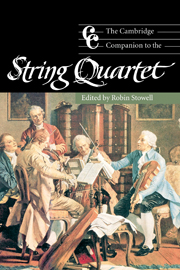Book contents
- Frontmatter
- Part I Social changes and organological developments
- Part II Celebrated ensembles
- Part III Playing string quartets
- Part IV The string quartet repertory
- 8 The origins of the quartet
- 9 Haydn, Mozart and their contemporaries
- 10 Beethoven and the Viennese legacy
- 11 The Austro-Germanic quartet tradition in the nineteenth century
- 12 Traditional and progressive nineteenth-century trends: France, Italy, Great Britain and America
- 13 Nineteenth-century national traditions and the string quartet
- 14 The string quartet in the twentieth century
- 15 The string quartet as a foundation for larger ensembles
- Notes
- Select bibliography
- Index
12 - Traditional and progressive nineteenth-century trends: France, Italy, Great Britain and America
from Part IV - The string quartet repertory
Published online by Cambridge University Press: 28 September 2011
- Frontmatter
- Part I Social changes and organological developments
- Part II Celebrated ensembles
- Part III Playing string quartets
- Part IV The string quartet repertory
- 8 The origins of the quartet
- 9 Haydn, Mozart and their contemporaries
- 10 Beethoven and the Viennese legacy
- 11 The Austro-Germanic quartet tradition in the nineteenth century
- 12 Traditional and progressive nineteenth-century trends: France, Italy, Great Britain and America
- 13 Nineteenth-century national traditions and the string quartet
- 14 The string quartet in the twentieth century
- 15 The string quartet as a foundation for larger ensembles
- Notes
- Select bibliography
- Index
Summary
Introduction
As has clearly been demonstrated in the previous chapters, the art of the string quartet was taken to its heights by the Austro-German composers of the late eighteenth and the nineteenth centuries. It was not until the second half of the nineteenth century that equally fertile traditions began to emerge elsewhere. These trends, discussed in this and the subsequent chapter, signal the development of the genre into a medium adopted by composers worldwide, who gradually exploited it as a vehicle for the most concentrated, the most experimental, the most radical as well as the most intimate compositional thought.
Austro-German influence nevertheless remained predominant; in Britain, for example, even the major string quartet ensemble of the second half of the nineteenth century, the (English) Joachim Quartet, was led by a German, Joseph Joachim. American composers had still to find their own voice; and whatever Italian ensembles there were continued to perform the works of the Austro-Germans to the exclusion of almost everything else, so immersed were their fellow countrymen in vocal music, and particularly in opera and in the instrumental traditions fostered by the Viennese Classical composers. Despite the relatively large number of string quartets composed in France during the nineteenth century, no distinctively French string quartet tradition developed until the late 1880s, when César Franck (1822–90) and his circle of composers contributed to a native quartet tradition in France, albeit with a strong German seasoning.
- Type
- Chapter
- Information
- The Cambridge Companion to the String Quartet , pp. 250 - 265Publisher: Cambridge University PressPrint publication year: 2003

